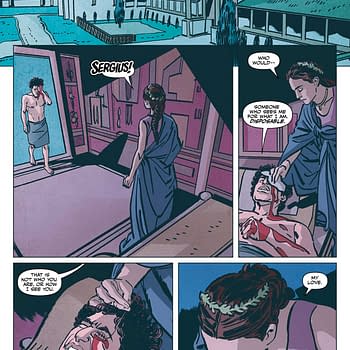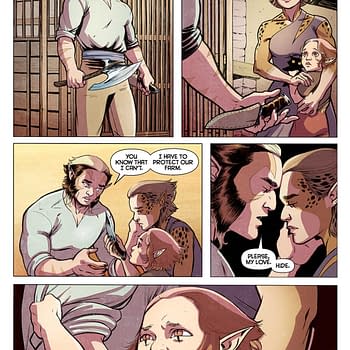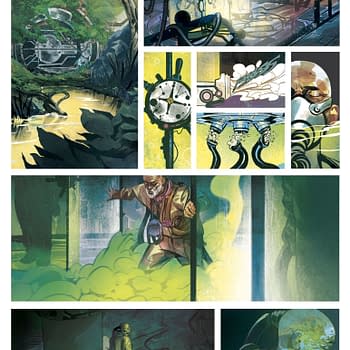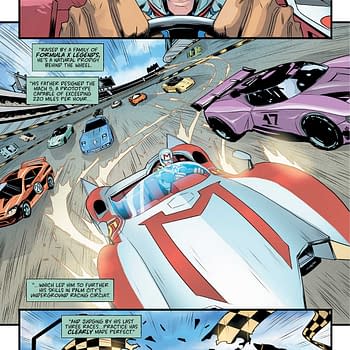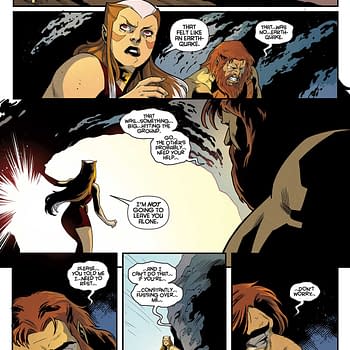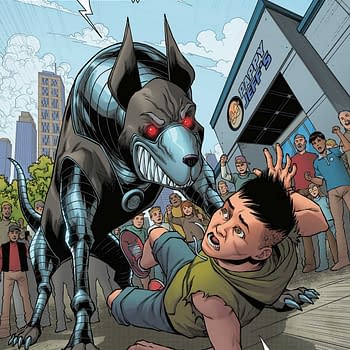Posted in: Comics, Recent Updates | Tagged: boom studios, brian bendis, Comics, cullen bunn, david marquez, dc comics, Drew Moss, entertainment, Fairy Quest: Outlaws #1, humberto ramos, image comics, jim lee, Kristina Collantes, Marvel Comics, Miles Morales: Ultimate Spider-Man Volume 1: Revival, oni press, paul jenkins, scott snyder, Superman Unchained #9, Terrible Lizard #1, The Humans #1, Tom Neely
Thor's Comic Review Column – Miles Morales: Ultimate Spider-Man Volume 1, Terrible Lizard, Superman Unchained, Fairy Quest: Outlaws, The Humans
This week's reviews include:
Miles Morales: Ultimate Spider-Man Volume 1: Revival
Terrible Lizard #1
Superman Unchained #9
Fairy Quest: Outlaws #1
The Humans #1
Miles Morales: Ultimate Spider-Man Volume 1: Revival (Marvel, $17.99)
By Graig Kent
I find Peter Parker kind of boring, and more than that, sometimes annoying. I don't judge fans of Spider-Man for liking him, and I do get why he's one of the most successful superheroes in the world, but he's just never been my cup of tea. But Miles Morales? He hits me right in my sweet spot with a Venom Blast.
Legacy heroes are my jam.
I grew up a DC kid, and DC Comics used to be all about legacies (well, not ALL about, but it was a large part of that universe's appeal). There were all the silver age versions of golden age heroes, and the bronze age versions of silver age heroes, and the modern reinventions trying to disconnect from legacy altogether, but invariably finding their way back. At DC, Wally West was the ultimate legacy character, even after two decades in the role of the Flash, he still had a hard time escaping the shadow of Barry Allen, until ultimately that dried up piece of milquetoast returned, and proceeded to destroy the DCU. The New 52 has almost altogether abandoned the theme of legacy as they try to reestablish the universe as a young, vital and new superhero playground.
Meanwhile, at the turn of the millennium, Marvel started toying with legacies like they never had before. Young Avengers had popped up with youthful variants of the big heroes, and Runaways was all about escaping one's legacy. There's X-23 and Daken (*shudder*), and even a junior Hawkeye under Clint Barton's wing. But Marvel never had an ultimate legacy character, not like Wally West, at least not until Miles Morales came along.
Peter Parker died, you see, killed by Norman Osborn. Miles, bitten at 12 years old by another of Oscorp's genetically altered spiders, was encouraged by his best friend Ganke to become the new Spider-Man. Miles took up the challenge, and it's been a roller-coaster ride since, to be sure. He was somewhat responsible for his uncle's death, his mother was killed when Venom attacked him, he met 616 Peter Parker, and he punched Galactus in the face. You lose some, you win some. What Miles brings to the role of Spider-Man is the trouble of juggling family, friends, and school with the need and desire to help people. Ultimate Spider-Man is also written keeping in mind the prevalence of surveillance technology in the world, as a result there's a definite impact on how the world sees Miles as a hero. Yet, even though the world has accepted this New Spider-Man, they've still deified Peter Parker post-mortem. Miles struggles with living up to his legacy, as much in his own mind as in public perception.
This first volume of the Ultimate Spider-Man series relaunch takes place after the events of Ultimate Cataclysm, where the Ultimate world faced down Galactus. Captain America, Thor, and Iron Man are dead or missing, and S.H.I.E.L.D. is being dismantled. Mutants are largely hailed as heroes. Times are changing. During this potentially world-ending event, Miles revealed to his father his alter-ego, and his father disappeared, blaming Spider-Man for the death Miles' mother. Miles checks in at home every day, just in case his dad comes back, but lives with Ganke's family instead of alone. He's got a girlfriend from his private school (the ultimate Kate Bishop, not "Lady Hawk-Guy" in this universe) whom he struggles to keep his secret from, and he's unsure whether to tell her. Meanwhile Norman Osborne, whom the world thinks is dead, escapes, and Peter Parker, whom the world also thinks is dead is still alive….and he wants his web shooters back. Say what?
This collection puts together the first 5 issues of the new series, as well as the Ultimate Spider-Man #200, which finds much of the Ultimate Spider-Man supporting cast reuniting for a celebration commemorating the 2nd anniversary of Peter's death. It does work as a good jumping on point, even though the spectre of Ultimate Parker looms large over Miles Morales. This spectre does the character a major disservice, constantly reminding him, and the reader, that he's not the original. In my mind, Miles is the Ultimate Spidey. At the same time, it's still fascinating reading. Miles' greatest weakness is the feeling that he doesn't deserve to be Spider-Man, and to pit him face-to-face with his idol/inspiration yields all the expected drama, conflict, quipping, and more. It's quite possible writer Brian Michael Bendis is crafting this story to address head-on Miles' insecurity, so that he can move past it, out of Peter's shadow. Or, perhaps, Peter really isn't dead, which kinda sucks if so.
Where Ultimate Spider-Man has worked the best in the past, and continues to work so very well, is in Miles' private life. Bendis doesn't shy away from costumed action sequences, but the challenges Miles faces in his civilian life carry so much more weight. Here, when Miles stresses about telling his girlfriend about his costumed life, he's worried about not just her reaction (his father left him when he told him afterall, that's got to mess a dude up), but what it means for their relationship if he tells her. Ganke offers his advice, but it's really only Mary Jane he can consult.
I think kids traditionally get a kick out of the Peter Parker power fantasy, a teenager with extraordinary super-powers who doesn't quite know what he's doing. As an adult, I find the fantasy is truly exploring what life would be like with super-powers and a secret identity, and Bendis continually nails it with this book, even if the legacy angle is at too sharp a point so far in this story.
Not enough good things can be said about David Marquez. When he first took over from Sara Pichelli I wasn't as sold, but he's grown into a ridiculously amazing illustrator, full of rich detail and exceptionally well-defined characters. Every single person in this book is a unique individual, their face, body type, style, mannerisms… Marquez brings the natural world to the pages filled with the supernatural. A more cartoonish style would highlight the fantasy, Marquez brings reality crashing down. Justin Ponsor is the book's secret weapon. His colors are gorgeous, and his sense of light and shadow simply unreal. It's hard to make the visual of a giant, flaming, demon-esque Green Goblin fit naturally into an otherwise realistic world but he makes it work.
If there's anything to truly complain about, it's that this volume doesn't collect a complete story. It leaves almost every plot thread dangling. It's a long wait for the next volume, but certainly anticipated.
Graig Kent is the author of Quarter City: An Urban Super-hero Fantasy, which is currently being posted a chapter a day on Wattpad, free to read. He also tweets @thee_geekent sometimes, and writers about movies and TV from time to time at wedisagree.blogspot.com.
Terrible Lizard #1 (Oni Press)
By Bart Bishop
Like every person my age, I love dinosaurs. At the ripe age of nine I saw Jurassic Park in theaters, and much like Jaws (Spielberg, you scoundrel) planted the seed of a life-long fascination with sharks, the former movie made me want to be a paleontologist. You know, like Ross on Friends. Of course that never happened, but to this day dinosaurs tickle my lizard brain, from raptors to the Dilophosaurus but especially the Tyrannosaurus Rex. So imagine my delight seeing the cover for Terrible Lizard #1 by Cullen Bunn and Drew Moss. A teen girl riding a T-Rex! The cover certainly sets the stage for what appears to be another science gone amuck story involving secret government labs, time travel, and kaiju action in the classic Godzilla versus King Kong tradition. There isn't a lot to go on just yet that hasn't been seen hundreds of times before, but the teenage lead, Jessica Anders, is refreshing in her unique perspective, even if that means inundating the reader with a thumping narration that does a lot of telling without showing.
After an opening showing the kind of mass destruction to be expected of a monster mash, this issue Tarantinos it back to a week earlier to set up how it all came to be. Immediately the audience is awash in Jessica's thoughts as she muses on the isolation of living at Cosmos Labs. Her father, Dr. Jefferson Anders, is a big-shot scientist not necessarily of the mad variety working on a time machine for the United States government. Why that is has yet to be revealed, but he's under close scrutiny by one Colonel Grayson, a no-nonsense machismo type that's all shoot first, ask questions later, then shoot again kind of guy. It's clear that tensions are high between Jessica and Jefferson, but surprisingly she's not responsible when things naturally go wrong with the time portal. She is, however, the recipient of a giant licking when a strangely polite T-Rex comes bounding into the modern day, establishing a relationship that will be key to this series when she defends the prehistoric beast from being put down by the soldiers.
Bunn handles the script well enough. As aforementioned, there's a lot of telling the reader that Jessica is the only young person at Cosmos Labs, and Jefferson's introduction is thick with exposition between him and Colonel Grayson about their respective jobs and the dangers involved. It all reads like military jargon and technobabble filtered through years of movies and bad science fiction, and lacks any ring of truism.
Where Bunn excels is in Jessica as a character. She feels like a teenage girl in her words, both in narration and dialogue, and actions, with simple things like skateboarding being presented without making a statement. She's bored, she's athletic, she's slightly rebellious and obviously the complete opposite of her father. Conflict naturally arises. What I most enjoyed about this issue, however, is its gentleness, a feeling that permeates the light-hearted tone of the entire issue. Too often teenage angst and family drama is rife with anger and hurtful darkness, but here it's simple loneliness that makes Jessica immediately identifiable. Her connection with Wrex, however much it stretches credibility, makes both of them engaging.
Moss's artwork is a little stiff at times, most notably when Jessica is first shown skateboarding there's not much dynamism to it, but has a versatility that lends itself to all walks of visuals. Jessica herself has a lived-in sensibility, with a fashion that evokes isolated 14-year-old girl astutely. Too often teen girls in comics are sexualized, so it's nice to see a character that has agency outside of how men view her. Wrex himself rides a fine line between fierceness and huggability, and it's commendable that Moss never anthropomorphicizes or neuters him.
The other monsters are only briefly glimpsed but promise Lovecraftian weirdness that's appropriately inappropriate for dry land, blending crustacean sensibilities with plant life to manifest something that truly shouldn't exist. There is also a cool bit of subtlety when Jessica is leaving her apartment and an old family photo is within the frame, revealing the absent mother that has left a hole in Jessica's life and a question mark in the story. Most impressive is the handling of sound effects, incorporated into the story in the tradition of Will Eisner, with SKREEEEE accompanying a skidding skateboard and RNNK? both being Wrex's growl and allowing him a bit of personality.
The pieces are all in place for a sandbox to bang action figures together, but luckily there's a strong central character at its core that isn't often seen in comics. And I'll always be a sucker for dinosaurs.
Editor and teacher by day, comic book enthusiast by night, Bart has a background in journalism and is not afraid to use it. His first loves were movies and comic books, and although he grew up a Marvel Zombie he's been known to read another company or two. Married and with a kid on the way, he sure hopes this whole writing thing makes him independently wealthy someday. Bart can be reached at bishop@mcwoodpub.com.
Superman Unchained #9 ($4.99, Image)
By D.S. Randlett (@dsrandlett)
Before I begin properly discussing this series, I want to point out its biggest flaw. It's too short. Superman Unchained was originally billed as something of an ongoing series, something that would end when it ended, with the implication that there would be more than one arc in the story. Earlier issues bear this out, as they are structured like several of DC's prestige ongoing series with backups by series writer Scott Snyder setting the table for plot elements that would bear fruit down the line. Unfortunately, Unchained seemed to be a casualty of Snyder art artist/publisher Jim Lee's work schedules.
As a result, there are a lot of ideas in the run that don't get fully explored throughout (I get the impression that there was going to be more Lex Luthor/Jimmy Olsen stuff, for example), which is pretty par for the course when it comes to ongoing superhero comics. Despite a certain feeling of incompleteness, Snyder and Lee managed to bring things in for a pretty satisfactory landing, wrapping up the biggest threads while providing something of a mission statement for their approach to the character.
Of course, when Snyder's script finally lets that cat out of the bag, that's what leaves me wanting more. For a lot of this series, Superman himself has been something of an enigma, and that is very purposeful. A big visual motif of this series is seeing Superman from far away, and then up close for a big action shot. It's something that's mirrored in how the story unfolds itself, we're intended to get separated from the character again, see him from afar. The story doesn't give so many "zoom in" moments as much as the art, but they are there, and it all establishes a weird emotional rhythm.
One moment you're alienated from Superman, and then there are these story moments where the character just crystallizes in a way that, as much as I like Greg Pak's Action Comics and the Johns/Romita Superman, he hasn't really quite done in the New 52. Snyder pulls back in order to stop taking the character for granted, and eventually brings the focus back to who he is and why he does what he does.
That approach all comes to a head in this final issue during an extended monologue by Lex Luthor, who Snyder uses to really air out his own thoughts about Superman. As a Superman enthusiast, I think that Snyder gets a lot really right. I'm saying this as a fan, but I think that a lot of the criticisms of the character come from a really shallow interpretation of him, and a really shallow view of fiction. Modern day heroic fiction is obsessed with becoming, with what we've called "The Hero's Journey." It's why we keep going back to the origin well so often, particularly with this character, but we do it with everything and keep trying to fit older stories into that template. Pick any heroic character ever, and odds are there's a movie coming out about them with the word "origins" in the title.
Of course, centuries of heroic storytelling confound this understanding of what makes good fiction. One need look no further than The Iliad itself, the Ur-text of the Western heroic tradition. Homer doesn't say, "Sing, Muse, of how Achilles became wrathful." He says, "Sing in me, Muse, the wrath of Achilles." Achilles is wrathful, and The Iliad is about what Achilles is. This is not to say that stories of becoming are invalid or shallow, just that these are not the only kinds of heroic stories worth our consideration, nor is becoming the only lens through which heroes can be analyzed.
Superman hails from the Achilles school of heroism. Not so much in terms of what he does or who he is, but in that his best stories are about being someone rather than becoming someone. In effect, the best Superman stories are about how the Self interacts with different concepts. Superman doesn't just stand for Truth and Justice, but he comes up against different permutations of these concepts all the time. He lives in a platonic realm of ideas, and stories that play on that are among the character's most enduring and fascinating.
From Unchained, I get the impression that Scott Snyder knows this about the character, and he throws so many ideological challenges at Superman that it makes one's head spin trying to pick them all apart. The first core idea of his run, serialized as the Chelsea Manning and Edward Snowden revelations were coming to light, found Superman in conflict with a vast national security apparatus called "The Machine." In the phase of the story, Superman took the role of the American citizen, often called irrelevant and ineffectual by military figure Sam Lane and later his own dark mirror image, Wraith. The name "The Machine" itself calls to mind a very modern feeling, where it often seems like our institutions have outstripped our own paltry human level. Conflicts and policy become abstracted, and apathy sets in. The military brass is essentially telling Superman that he can hang it up. After all, we've outgrown ideas like Morality. All we really need is the idea of Purpose, right? To the military of Unchained, Superman acts without their Purpose. He has no dogma.
This leads us to the main thread in this series: Antagonists telling Superman that he doesn't have what it takes to make "the really hard decisions." This is the subject of Luthor's monologue, and Wraith and Sam Lane accuse Superman of this constantly. What Luthor really hates about Superman (in this issue, anyway) is that Superman doesn't have a plan for what he does, no vision for how to use his power. Lex Luthor knows what he would do, of course, because he knows best. As does General Lane. Or Wraith. These are all characters that, throughout the series, have essentially called Superman a coward throughout the run. They are also all characters who spend most of the series motivated by one sort of dogma or code or another. And they're right about Superman. He doesn't have a code. He has a compass, and it's this that Superman Unchained posits as the character's greatest strength. To go from situation to situation and to try and suss out the Right or the Good on a case by case basis without the crutch of an ideology or dogma is not only how most of us have to live everyday (we irrelevant ones), but also one of the most morally courageous things that anyone can do.
Unchained revels in that aspect of Superman, and highlights his own uncertainties as an element of his moral courage, culminating in a moment of moral liberation for a certain character. Unchained proves that Snyder gets Superman the way he gets Batman, and makes me hope for his return to the character someday. He's made his mission statement, but it feels like there's still room for Snyder to play in this particular sandbox.
D.S. Randlett lives in the hills of Virginia and takes credit for the reviews that his emaciated twin brother writes while chained to the old radiator. He plays his guitar while biding his time for unsuspecting tourists and thinking about going to grad school.
Fairy Quest: Outlaws #1 (Boom!, $3.99)
By Cat Taylor
It seems like fable and fairy tale related comics, TV shows, and movies are becoming as common as super-hero comics, TV shows, and movies. As potential partakers of mass media entertainment, we can complain that they've already been done to death or we can accept it as a genre of its own and base our opinions on each individual piece of work. I am going to attempt to do the latter with this review but comparison to similar material is inevitable.
Although this is technically a new issue of a new series, the creators did something rather unusual with this release. Some time ago, Humberto Ramos and Paul Jenkins, who are best known for their work on a few different Spider-Man comics, launched a Kickstarter campaign to raise funds to release a Fairy Quest: Outlaws graphic novel and, according to my research, they succeeded. However, now they have chosen to release the same story in two single regular comic book issues. Who knows why they took the opposite approach of most publishers, but it will most certainly be a cause to rethink the current publishing model of most comic books if their method proves to be successful.
As for the story itself, Jenkins has crafted a tale with common folklore characters such as Red Riding Hood, the Big Bad Wolf, and Rapunzel but he has cast them in different roles and with different relationships to each other than they are known from their original stories. However, he has not taken the Fables or Once Upon A Time route and turned them into mature action heroes. Most of the characters are portrayed as children and haven't been given any special powers or anything like that. This approach makes this comic a story that would be most appropriate for pre-teen readers.
That doesn't mean that older readers won't appreciate it, because it is a fun read with witty dialogue, but the older readers will likely appreciate it as a very good children's story. This issue is especially conducive to Ramos' art-style. I recall some of his previous work on a Spider-Man story where I found his cartoony, angular style to be an odd fit. Here, on the other hand, it is entirely appropriate and adds plenty to the feel and spirit of Jenkins' story. In addition, it's worth mentioning that this is one of those comic books where the work of the colorist, Leonardo Olea, also stands out. The work of a colorist can often be overlooked and sometimes that's because it doesn't add much. Olea's work, on the other hand, is vibrant and has as much to do with the atmosphere in the story as the illustrations.
If I have any criticism at all about this issue, it would have to be that despite not following the trend of turning public-domain folklore characters into action heroes, the plot here where Mr. Grimm is attempting to keep all the fairy tale characters in their "box" so that they don't break character and come up with their own ideas, is similar to an earlier story arc from Jack of Fables featuring a villain called Mr. Revise. I hope Ramos and Jenkins will end up handling the story differently in the long run, but my initial gut reaction was that this idea has already been used recently. Similar plotlines are inevitable when dealing with similar characters and settings. Fortunately, it hasn't negatively impacted my enjoyment so far and based on the first issue I'm optimistic that it won't. If you have children or are a child at heart, Fairy Quest: Outlaws is a great introduction to kids' comic books that aren't crap. There's also clearly a moral emerging about thinking independently and not always relying on "the way it's always been done." I'm not a parent myself but if I had kids, it's a lesson I would want them to learn.
Cat Taylor has been reading comics since the 1970s. Some of his favorite writers are Alan Moore, Neil Gaiman, Peter Bagge, and Kurt Busiek. Prior to writing about comics, Taylor performed in punk rock bands and on the outlaw professional wrestling circuit. During that time he also wrote for music and pro wrestling fanzines. In addition to writing about comics, Taylor tries to be funny by writing fast food fish sandwich reviews for Brophisticate.com. You can e-mail him at cizattaylor@hotmail.com. You also know that you've been sitting in a restaurant too long when you hear the same Sammy Hagar song on their sound system twice. I think I've lost my appetite.
The Humans (Image, $3.99)
By Jeb D.
It makes sense that corporate superhero comics have become more and more writer-centric, as conjoined plotting between and among series and crossover events, and juggling the storylines, drives publishing schedules at the Big 2,. Even the best of today's superhero artists are usually measured on their ability to illustrate a story, rather than actually tell one. The various smaller publishers are often home to outstanding writer-artists (see: A Voice InThe Dark, Rachel Rising, etc.) who obviously exert a more precise level of control on the script/art balance.
But every now and again you encounter a comic that splits the difference in an interesting fashion, one where, even though the creative team is in perfect sync, what the artist adds to the script is something that is so wholly unique and distinctive as to transform the script. And, thus, The Humans.
Obviously, a lot of readers will already know the premise (or will have guessed from the cover image), but for those who haven't:
The Humans is about a biker gang, in 1970 Bakersfield, California. We are introduced to the various members of the Humans at a funeral for fallen comrade Mojo, and writer Keenan Marshall Keller uses a crudely eloquent funeral oration, and punchy dialog, to quickly sketch out personalities and relationships; the feeling is less Sons of Anarchy and more The Wild Angels. The slang has hints of the 60's, but with its own idiomatic rhythm. A drunken wake in the cemetery follows, including some decidedly NSFW material (this may not be the first blow job I've ever seen in an Image comic, but it's probably the first time I've seen the guy's cock pop out of the startled woman's mouth), interrupted by the arrival of a rival gang, the Skabbs. Taunts and insults fly, and a melee breaks out, ending inconclusively. The two gangs retreat to lick their wounds, and as the Humans give Mojo a final sendoff, we get our first hints of the revelations that will drive the rest of the series. It's a taut, tidy script, redolent of Nixon-era ugliness.
And The Humans? Well, they're apes. So are the Skabbs. Not Andy Serkis-type realistically-appointed creatures, but animals of human stance, stature, and manner, whose heads and faces just happen to cover the range of chimps, orangutans, gorillas, etc. Why biker apes? It's tempting just to say "Why not?" They never act like anything but humans, and there are no "real" humans in the story to give us Planet of the Apes-style interspecies conflict. But The Humans are apes for the same reason that Fritz the Cat was a cat: it gives a distinctively interesting vision to the story, personifies much human behavior we ascribe to animal instincts, and calls back very specifically to the underground comics of the 60's and 70's: fans of the Furry Freak Brothers, or anything that appeared in the early years of the National Lampoon's comics section, will either be dazzled, or have a wicked flashback.
Artist and co-creator Tom Neely does an amazing job of bringing the simian cast to life in the early graveyard scenes, but the highlight of the issue is the gloriously demented double-page spreads when the Skraggs and Humans go at it: grotesque facial expressions, wild sound effects, and colorist Kristina Collantes makes the brawl (and the entire issue) an explosion of psychedelia.
Keller, Neely and Collantes go all-in with their Vietnam-era aesthetic: the frontspiece and backmatter are the color of a yellowed comics page, there's a coupon you can cut out to join their fan club, and they've even arranged for the free downloading of some vaguely period-sounding badass rock from bands the Zig-Zags and Smelly Tongues (personally, I heard Deadbolt as I was reading).
I don't mean, in any way, to diminish the coordination and teamwork that must have gone into the creation of The Humans. But you could hand Keller's script to any of a hundred artists, and while you might get some pretty good hard-ass biker-gang comics, what Neely and Collantes do with it is a kind of alchemy that I doubt even Keller could have fully envisioned beforehand. Highly recommended.
Jeb D. is a boring old married guy whose comics background includes attending the very first San Diego Comic-Con, being lectured on Doc Savage by Jim Steranko, and fetching an ashtray for Jack Kirby. After a quarter-century in the music biz, he pursues more sedate activities these days, and will certainly have a blog or Facebook account or some such thing one day.















